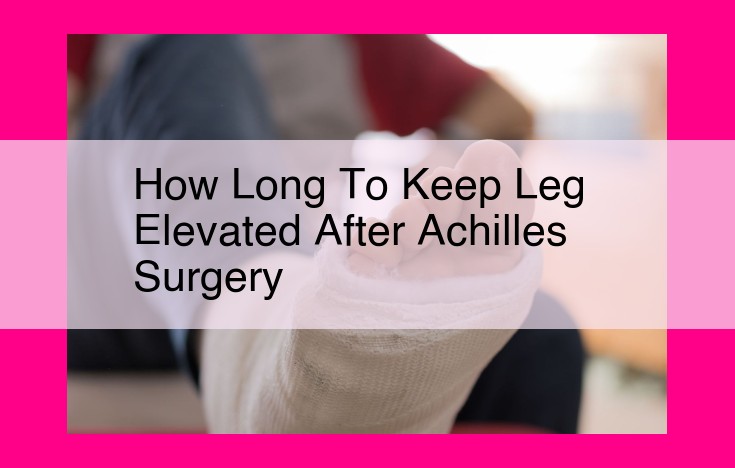Achilles Surgery Recovery: Essential Leg Elevation Guide For Optimal Healing

After Achilles surgery, it is crucial to keep the leg elevated to reduce swelling and promote healing. The duration of elevation varies depending on the surgical procedure. Generally, elevation is recommended for 2-4 weeks after Achilles tendon repair and for 1-2 weeks after Achilles tendon lengthening. Elevating the injured leg above heart level helps reduce pain, swelling, and pressure on the surgical site, facilitating proper tissue healing and recovery.
Understanding Achilles Tendon Injuries
Achilles Tendon Rupture: A Sudden and Debilitating Tear
The Achilles tendon is a strong, fibrous cord that connects your calf muscles to your heel bone. When this tendon is torn or ruptured, it can cause intense pain and sudden disability. Achilles tendon ruptures often occur during sudden, forceful movements or sports activities.
Symptoms of a ruptured Achilles tendon include:
– Sudden, sharp pain in the back of the ankle
– Inability to walk on tiptoe
– Bruising and swelling around the ankle
– A palpable gap or defect in the tendon
If you suspect an Achilles tendon rupture, it’s crucial to seek immediate medical attention. Prompt diagnosis and treatment can improve your chances of a successful recovery.
Achilles Tendinitis: Inflammation and Overuse
Achilles tendinitis is a common condition that involves inflammation of the Achilles tendon. It typically develops due to overuse or improper biomechanics, such as:
– Excessive running or jumping
– Poor-fitting shoes
– Tight calf muscles
– Biomechanical imbalances
Symptoms of Achilles tendinitis include:
– Gradual onset of pain in the back of the heel
– Tenderness to the touch
– Stiffness in the morning or after rest
– Pain that worsens with activity
Treatment for Achilles tendinitis typically involves rest, ice, and compression. Strengthening and stretching exercises may also be beneficial.
Haglund’s Deformity: A Bump on Your Heel
Haglund’s deformity is a bony bump that forms on the back of the heel. It can irritate the Achilles tendon, causing pain and discomfort. Haglund’s deformity is often caused by:
– Ill-fitting shoes
– Repeated friction or pressure on the heel
– Overpronation (inward rolling of the feet)
Symptoms of Haglund’s deformity include:
– Pain and swelling in the back of the heel
– Redness and irritation
– Stiffness in the heel
– Difficulty wearing closed-heel shoes
Treatment for Haglund’s deformity may involve:
– Wearing orthotics or heel pads
– Stretching exercises to improve range of motion
– Surgery to remove the bony bump (in severe cases)
Treatment Options for Achilles Tendon Injuries
When dealing with Achilles tendon injuries, the severity of the condition will determine the appropriate treatment approach. Various non-surgical and surgical options are available to address the pain and restore function.
Non-Surgical Treatments
Non-surgical treatments aim to provide support, reduce inflammation, and promote healing.
- Casting/Booting: Immobilizing the foot and ankle in a cast or boot can protect the injured tendon and allow it to heal.
- Splinting: Braces or splints stabilize the foot and reduce stress on the tendon, promoting alignment and recovery.
- Elevation: Keeping the injured foot elevated above heart level helps reduce swelling and improve circulation.
- Physical Therapy: Targeted exercises and treatments strengthen the tendon, improve flexibility, and reduce pain. Rehabilitation is crucial for a full recovery.
Surgical Treatments
In severe cases, surgery may be necessary to repair or lengthen the Achilles tendon.
- Achilles Tendon Repair: This procedure repairs a ruptured or torn tendon surgically, restoring its function.
- Achilles Tendon Lengthening: This surgery lengthens the Achilles tendon, typically to alleviate heel pain or plantar fasciitis.
Choosing the Right Treatment
The choice of treatment depends on the extent of the injury, the patient’s overall health, and their activity level. Your doctor will discuss the best options and guide you through the recovery process.
Remember, while these treatments can help manage Achilles tendon injuries, rest, patience, and following medical advice are essential for a successful recovery.